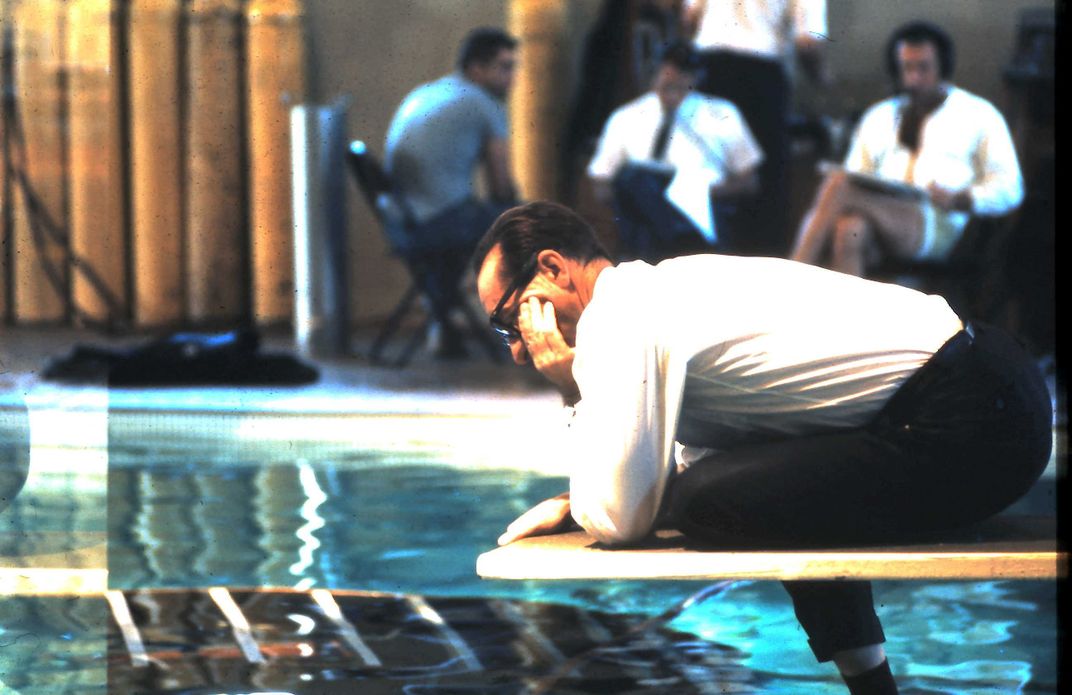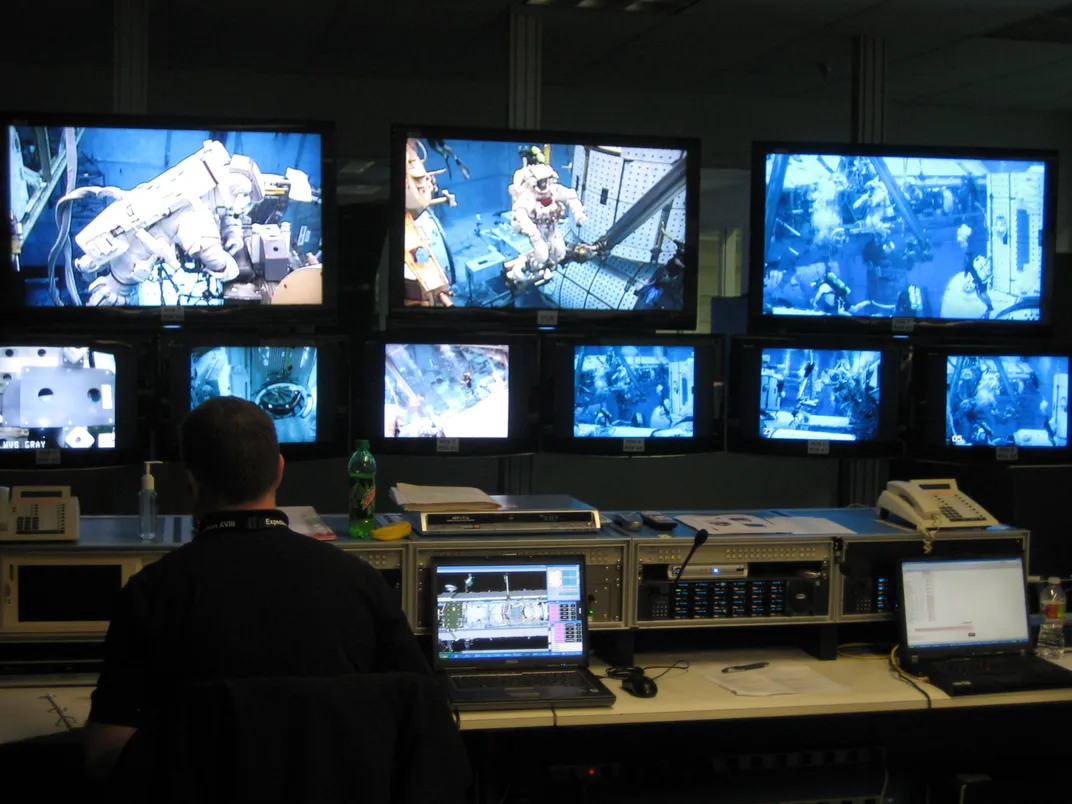Where NASA Learned to Spacewalk
Gemini astronauts jumped into this Maryland pool to experience working in space.
/https://tf-cmsv2-smithsonianmag-media.s3.amazonaws.com/filer/cb/59/cb5908bd-02e1-41fa-8a67-6a7756795ecf/17c_sep2014_sammattingly_live.jpg)
I got my first space-suited glimpse of the International Space Station not in the vacuum of space but 40 feet down at the bottom of the Johnson Space Center’s six-million-gallon Neutral Buoyancy Lab in Houston. I spent more than 200 hours suspended among full-scale replicas of the station’s trusses, modules, and a space shuttle cargo bay, honing my skills for three extravehicular activities—the NASA term for spacewalk—I would perform during mission STS-98 in February 2001.
Sam Mattingly was a trailblazer who made those spacewalks possible. Nearly half a century ago, in a Baltimore swimming pool, his small group at Environmental Research Associates invented the techniques of neutral buoyancy simulation. A Baltimore native and World War II C-47 flight engineer, Mattingly co-founded ERA with Harry Loats. In 1963, Sam and his fellow ERA engineers were analyzing spacecraft configuration and docking concepts for NASA’s Langley Research Center in Hampton, Virginia.
Langley had built a transparent plastic mockup of an airlock and hatch to evaluate the structure’s suitability for astronauts, but it was obvious “that a pressure-suited man in normal gravity would not be agile enough to crawl through the airlock,” Mattingly wrote in his memoir. He, Loats, and Langley’s Otto Trout wrestled with the problem until they hit upon an idea that seemed crazy: practical answers might be found underwater, where neutral buoyancy could largely eliminate the effects of gravity on the astronaut’s motion.
Mattingly persuaded personnel at nearby Norfolk Naval Air Station to loan him a Mark IV pressure suit (the kind worn by the Mercury astronauts), an oxygen tank, and a regulator. Sinking the airlock mockup in the Langley Air Force Base swimming pool, a suited Mattingly jumped in feet first, wearing lead diving shoes and gripping weights in each hand. Limited by the six-minute oxygen supply in the tank, he managed only a handful of evaluations before the Air Force reclaimed the pool. He needed more time.
Near ERA’s Randallstown, Maryland office was the private, all-boys McDonogh School. Mattingly struck a deal to rent the pool during off-hours, but space race or no, the headmaster insisted ERA pay the same rate as the local Red Cross swim course: $10 an hour. Mattingly thought that sounded fair.
ERA hauled the mockup and pressure suit gear up to Baltimore, hired safety divers and cameramen, and got to work. On July 18, 1964, Mattingly slipped beneath the surface of the McDonogh pool. With pouches of heavy welding shot strapped to the suit limbs, he suspended himself outside the airlock. He was transported: “I was in space, in weightlessness,” he says. The ensuing simulations gave NASA accurate data on the challenges of hatch opening, airlock ingress, turning around, and egress.
ERA’s increasingly ambitious tests couldn’t have been more timely. Astronaut Ed White’s pioneering Gemini 4 spacewalk in 1965 went reasonably well, but on Gemini 9 the following year, Gene Cernan could not control his body in free fall. Exhausted and blinded by visor fogging, Cernan nearly perished; he was barely able to jam himself back into his seat and seal the hatch.
Gemini crewmen found it nearly impossible to maneuver the stiff pressure suit in zero-G without tethers and adequate handholds and footholds. NASA, deceived by results from weightlessness simulations aboard its KC-135 aircraft that lasted a mere 25 seconds, “didn’t really know what the hell they were doing,” Mattingly told me.
ERA was already engaged in underwater testing for what later became the Skylab space station. The firm’s spacewalk work impressed Gemini program troubleshooter Don Jacobs, visiting from Houston. Jacobs arranged a demo at McDonogh of the Gemini 10 spacewalk tasks. “We ran that script underwater and showed that some tasks weren’t doable—unless you had three hands,” says Mattingly. During his Gemini 10 EVA, Michael Collins had a frustrating experience that confirmed the prediction. Leaping across a dozen feet of empty space from his Gemini capsule to a drifting Agena docking target, he found no handholds, and had to haul himself back via his umbilical and try again. The second time he grabbed a wire bundle, forcing him to perform his tasks one-handed. Tired, sweating, and tugged continuously off balance by the coils of the 50-foot umbilical, Collins just managed to get back inside the Gemini and close the hatch. The exasperating EVA lasted just 39 minutes.
Jacobs prompted Mercury veteran Scott Carpenter to visit McDonogh. Armed with a power tool, a submerged Carpenter tried his hand at releasing 72 hatch bolts from a Saturn third stage “wet workshop.” “In 30 minutes, he got maybe one bolt off,” says Mattingly, who remembered Carpenter’s lament over his stiff gloves: “I can’t bend my [expletive] finger anymore!”
Dick Gordon’s frenetic training regimen denied the Gemini 11 astronaut the opportunity to benefit from footage of ERA’s neutral buoyancy tests; sure enough, exhaustion forced termination of Gordon’s EVA after only 30 minutes. By September 1966, managers were pushing to get Gemini 12’s Buzz Aldrin up to McDonogh. Skeptical chief astronaut Alan Shepard resisted: “I will not dump my astronauts in the water without a written order from [Manned Spacecraft Center director] Dr. Gilruth.” Within hours, Shepard got just such a memo, and Aldrin was on his way.
Training on a Gemini adapter section submerged in the McDonogh pool, Aldrin ran through a series of two-hour exercises, working out how to use footholds, handrails, tethers, and tools. “He was a quick study,” says Mattingly, “the smoothest of anyone who came in.” Aldrin’s successful Gemini 12 spacewalks launched NASA into the Apollo era, confident that EVA was doable.
Now 88 and living in Ocean Pines, Maryland, Sam Mattingly reflects on his firm’s pioneering work. “We were excited to be involved in it,” he says. I describe to him my own hours spent submerged in the Houston successor to McDonogh’s pool, and in free fall EVAs outside the space station, and I see the look in his eye. He’s right there, outside—transported.


